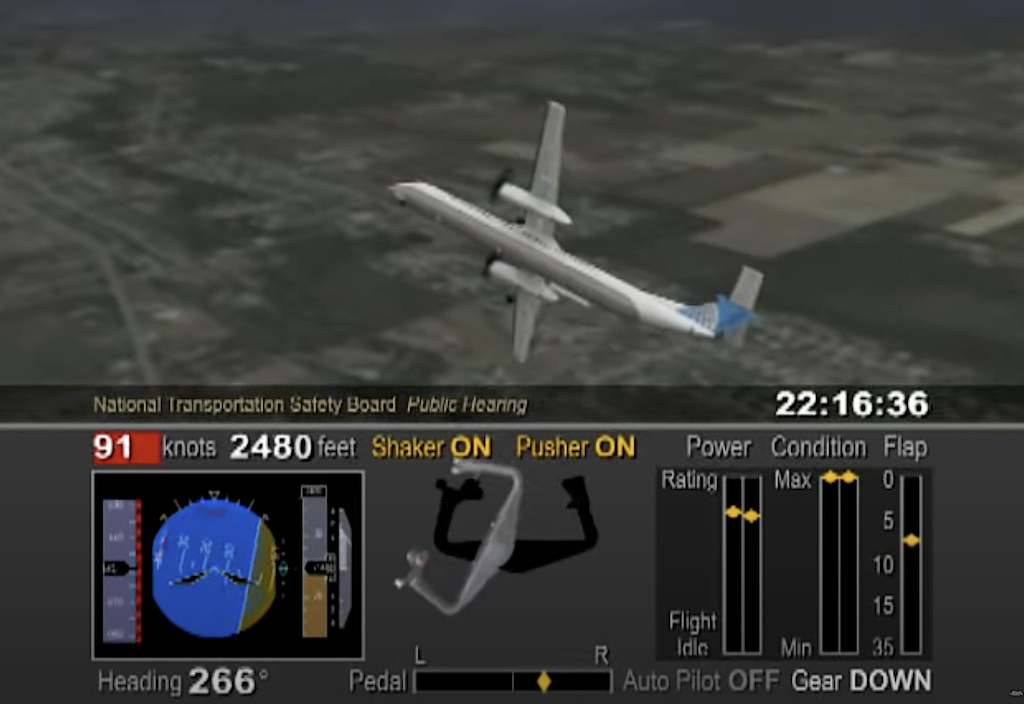
Flight animation of Colgan Air Flight 3407, which crashed in Buffalo on Feb. 12, 2009.
I’m going to speak for just myself here. Maybe I’m the problem. To me, current instruction on tail plane icing is not simple, straightforward or easy to implement. I also think it may not accomplish the desired goal because, at least in my case, I do not understand it.
Everything I have ever known or written on stalls was that recovery can only be achieved through a reduction in angle of attack (AOA). When the narrator in a NASA video states, “In the event of an impending tail plane stall, the pilot should immediately pull the yoke back and retract flaps to the previous setting,” I stop connecting the dots.
I see myself in an icing situation and sensing the stated characteristics of tail plane stall—namely, control versus airframe buffet, control force lightening and tendency toward pilot-induced oscillations. Do I just hold the yoke and resist forward pressure? Do I pull back 5-6 in. as the narrator demonstrates? If I’m supposed to pull back, when do I do that? What is meant (time-wise) by "impending?"
Again, I picture myself in an airplane that has a flying surface, the tail plane, on the ragged edge of critical AOA, with airflow separating from the rear and, due to icing, from the front. Am I to believe the remedy is to increase the AOA on that tail surface? That’s what pulling back in the event of impending tail plane stall means to me.
In the video, when the crew experiences a full tail plane stall, several things stand out. The pilot is describing the situation as: “very, very hard to control speed and even attitude. Forces going as high as maybe 80 pounds randomly and I can’t add any more power at this point.”
There can be no doubt that the airplane is in an “impending” tail stall situation at that point, but the pilot did not pull the yoke back, as did the narrator, at that point. I understand these were test pilots, trying to get as close as possible to a full tail stall, so that might be why they did not pull the yoke back.
Nevertheless, it begs the question in my mind of what would have been the result, if two seconds before the stall, the pilot “pulled back” on the yoke as far as the narrator suggested? In other words, in those moments when the tail plane stall is “impending.”
If we assume the crew was purposely trying to experience a tail plane stall, they still do not first pull back on the yoke after they achieve that goal. Is that when the pull back is supposed to occur? Having carefully watched that stall many times, I note that the pilot’s first action was to, correctly, let the nose fall through while simultaneously pulling the power to what appears to be idle. This slams all the tuffs onto the control surface. The tail has been “unstalled,” almost instantly. Those two steps gave the pilot a flying tail plane that would sustain his pulling the yoke back.
Add to the above, the first officer, without being commanded, starts the flaps up. “They’re already moving. I started them up when it went over.” Given that many flap systems move fastest from full down to approach, that one action alone, accomplished at the point of stall, probably would have un-stalled the tailplane in the nearly 2 sec. before the pilot pulled back.
The point is made in the NTSB investigation of the 2009 Colgan Air crash that the video in discussion here had no effect on that crew or airplane.
Regardless of whether the Colgan Air crew saw the video, they did exactly what I think inexperienced pilots might think the NASA crew did or instructed them to do. Approaching a low airspeed stall, the pilot aggressively pulls back on the yoke as if thinking a tail plane stall is impending. The pilot gets away with pulling back on a yoke that has activated the stick shaker. This could confirm an ice-contaminated tail plane stall in his or her mind. Further, if the first officer, as in the video, were to move the flaps without being commanded, that would aggravate the wing stall situation they actually were experiencing.
In fact, the Colgan Air co-pilot did exactly that, and the NTSB rightly dinged her for moving them without a command to do so.
Moving the flaps without being commanded is perfectly legitimate with two highly qualified test pilots in a situation that was probably briefed in great detail, but the warning the narrator gives could easily be lost on a less-experienced pilot. Again, I’m speaking of any low-time pilot here.
Because of the possibility of a young pilot interpreting “pull back on the yoke” to mean more than “hang on to the yoke,” I view it as “negative training” for that point alone.
But there is a larger problem that I think we can correct.
The video states that “tail plane stall due to ice accretion is rarely a problem in cruise flight because the tail is not operating anywhere near its performance limits.”
It is a problem in landing.
Approaching In Icing Conditions
We cannot cover every potential for disaster, but we can try to hit the most likely scenarios. It is time for a simple “Approach In Icing Conditions” procedure. It should offer guidance that would minimize loss of control possibility while taking away the need to determine if we have wing stall, tail stall or both while in a situation where the ol' brain box is approaching saturation.
I offer the following as a starting point. There will and should be other ideas added.
- When icing is expected, plan a no-flap or approach flap (airplane-specific) approach.
- Guard the yoke to keep it from rapidly moving forward. Do not push or pull the yoke. Guard it.
- If the flaps were already extended, retract to the approach position. (This gives up a lot of drag and downwash and a little lift). It seems flaps are the prime determinant of tail plane icing problems. Use caution as you may have to give up altitude to do this in a wing stall situation.
- If possible, add power to regain level flight. This would be appropriate in either icing situation. The test pilot in the NASA video adds power right after he recovers from the stall.
- If power advance results in more instability, attempt to balance power and back pressure to level where the airplane can be controlled even if this results in descent.
This sounds like we are sentencing the pilots to ground impact, but that is a function of where they detect the problem, just as it is, no stalling of the wing or tail—and they would not have wasted time trying to decide what is going on with the two different surfaces.
To read Instruction Needed For Tail Plane Icing, Part 1, click here.





